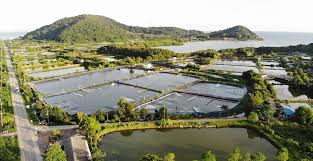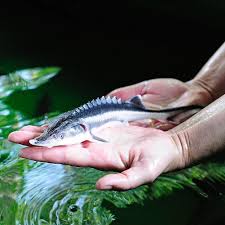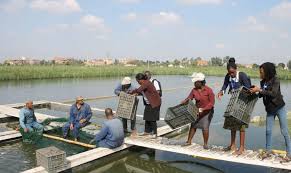Aquaculture Practices have become an essential part of the global food production system, providing a sustainable source of fish, shellfish, and aquatic plants. As demand for seafood continues to rise, aquaculture offers a viable solution to meet this need while helping to alleviate the pressures on wild fish populations.
These practices involve the controlled cultivation of aquatic organisms in various environments, such as freshwater, brackish water, and marine systems. Aquaculture can take place in open water, such as coastal and offshore locations, or in land-based systems like ponds, tanks, and raceways.
The diversity of aquaculture practices reflects the variety of species raised and the environmental conditions in which they are cultivated. Popular species include finfish like salmon, tilapia, and catfish, as well as shellfish such as shrimp, oysters, and mussels.
In addition, aquaculture encompasses the farming of seaweed and other marine plants, which have applications in food, cosmetics, and biofuel production. Each species and habitat requires unique methods and techniques to optimize growth, health, and yield, making aquaculture a complex but adaptable industry.
Aquaculture practices can be broadly categorized into three main types: extensive, semi-intensive, and intensive systems. In extensive systems, organisms are farmed in natural or artificial bodies of water, relying on natural food sources. These systems require less maintenance and capital investment, but they typically yield lower production volumes.
Semi-intensive systems supplement natural food sources with additional feed, allowing for higher stocking densities and improved growth rates. Intensive systems, on the other hand, involve the use of specialized feeds, high stocking densities, and controlled water quality conditions. While intensive systems have higher production outputs, they also require more resources, such as energy and advanced technology.
Aquaculture practices offer several environmental and economic benefits. By cultivating aquatic species in controlled settings, aquaculture can reduce the pressure on overexploited wild fisheries, helping to conserve marine biodiversity.
Additionally, many aquaculture systems are designed to have minimal environmental impacts, such as recirculating aquaculture systems (RAS), which recycle water to reduce waste and resource consumption. Economically, aquaculture creates jobs and supports local communities by providing income opportunities and increasing access to affordable protein sources.
However, aquaculture also faces several challenges, particularly in managing environmental impacts and ensuring sustainable practices. Issues such as water pollution, disease outbreaks, and the use of wild fish as feed can affect the ecological balance and raise concerns about the long-term sustainability of certain practices.
Additionally, ensuring fish welfare and minimizing the use of antibiotics and chemicals are essential to promote responsible aquaculture. Addressing these challenges involves implementing best practices, adopting new technologies, and adhering to regulations that support sustainable growth in the industry.
As the world’s population continues to grow, the need for sustainable food sources like aquaculture will become increasingly important. Innovations such as integrated multi-trophic aquaculture (IMTA), where different species are farmed together to reduce waste and improve resource efficiency, and advancements in breeding and feed technology are helping to shape the future of aquaculture.
With a focus on sustainability and responsible management, aquaculture has the potential to provide a stable and nutritious food supply while minimizing its impact on the environment.
Read Also: Economic Advantages and Management of Fishery Resources
Types of Aquaculture Systems

There are several types of aquaculture systems, each with unique features suited to various farming environments and species:
1. Pond Systems: The most traditional form of aquaculture, pond systems are cost-effective and ideal for growing various fish species. Ponds can be natural or constructed and rely on natural ecosystems to support fish growth.
2. Recirculating Aquaculture Systems (RAS): These systems recycle water within the system, minimizing water use. RAS allows for precise control over water conditions, making it suitable for high-density fish farming and indoor facilities.
3. Cage Systems: Fish are kept in large cages or net enclosures placed in natural bodies of water, such as lakes or oceans. Cage systems allow natural water flow, reducing the need for water treatment but requiring careful monitoring for environmental impacts.
4. Flow-through Systems: Water continuously flows through tanks or raceways, where it is circulated from a natural water source, such as a river or stream. This system is commonly used for trout and salmon farming and relies on a steady water supply.
5. Integrated Multi-Trophic Aquaculture (IMTA): IMTA combines different species at various trophic levels (e.g., fish, shellfish, and seaweed) in one system. This approach maximizes resource use by creating a balanced ecosystem where waste from one species becomes food for another.
Site Selection for Aquaculture
Choosing the right site is crucial to the success of an aquaculture operation. Key factors to consider include:
1. Water Availability and Quality: Ensure the site has a consistent water supply that meets quality standards for the species being farmed. Access to clean water is essential for fish health and growth.
2. Soil Quality: Test soil conditions, especially if planning to construct ponds. Clay-rich soils are ideal for pond systems because they help retain water and prevent seepage.
3. Climate and Temperature: Select a site with climate conditions suitable for the target species. Different fish species have specific temperature ranges required for optimal growth.
4. Accessibility and Infrastructure: Consider the location’s accessibility to transportation routes, electricity, and facilities for processing and storage. Being near markets reduces transportation costs and improves efficiency.
5. Environmental Impact: Assess the potential environmental impact of the operation. Ensure the site complies with regulations to protect local ecosystems, water resources, and wildlife.
Water Quality Management
Maintaining optimal water quality is essential for fish health and production. Key elements of water quality management include:
1. pH Levels: Monitor and maintain pH levels within the appropriate range for the species. Most freshwater fish thrive in a pH range of 6.5 to 8.5. Regular testing helps prevent stress and health issues.
2. Dissolved Oxygen: Fish require adequate oxygen levels to survive. Use aeration systems, like air pumps or diffusers, to maintain oxygen levels, especially in high-density systems or during warm weather.
3. Temperature Control: Maintain water temperatures within the species’ ideal range. Temperature influences fish metabolism, growth rates, and immunity. In controlled systems, use heaters or chillers to manage temperature.
4. Ammonia and Nitrite Management: Monitor ammonia and nitrite levels, as they are toxic to fish. Use biological filtration or water exchange systems to break down waste and control harmful substances.
5. Salinity (for Marine Systems): For saltwater aquaculture, ensure salinity levels match the species’ needs. Regularly test and adjust salinity by adding fresh or saltwater as needed.
Aquatic Species Selection
Choosing the appropriate species for aquaculture involves understanding environmental conditions, market demand, and the specific needs of each species. Key factors to consider are:
1. Climate Compatibility: Select species that thrive in the climate and water conditions of the area. Warm-water fish like tilapia prefer temperatures above 25°C, while cold-water fish like trout require cooler environments.
2. Growth Rate and Feed Efficiency: Species that grow quickly and efficiently convert feed into body mass are often more profitable. Salmon and catfish are examples of species with favorable growth and feed conversion ratios.
3. Market Demand and Profitability: Research market trends to determine which species are in demand. Popular choices include tilapia, shrimp, catfish, and trout due to their high demand and economic returns.
4. Disease Resistance: Some species are more resilient to common aquaculture diseases. Choosing species with natural resistance or adaptability to the farming environment reduces the risk of disease outbreaks.
Aquaculture Feeding Techniques
Proper feeding is essential for optimal growth, health, and cost-effectiveness. Here are some common feeding techniques in aquaculture:
1. Manual Feeding: Farmers hand-feed fish by scattering feed over the water surface. While labor-intensive, it allows for close observation of fish behavior and feed intake, making it ideal for small-scale operations.
2. Automatic Feeders: These devices distribute feed at set intervals, ensuring consistent feeding and reducing labor costs. Automatic feeders are often used in larger aquaculture systems to improve efficiency.
3. Demand Feeders: Activated by fish themselves, demand feeders allow fish to eat when they are hungry. This approach helps minimize feed waste and ensures that fish are well-fed, particularly in intensive systems.
4. Floating and Sinking Feeds: Choosing the right type of feed is crucial. Floating feeds allow farmers to monitor feed intake, while sinking feeds are better for bottom-dwelling species like shrimp and catfish.
Disease Prevention and Health Management
Disease prevention and management are critical in aquaculture to maintain healthy stocks and prevent losses. Key strategies include:
1. Biosecurity Measures: Implement strict biosecurity protocols to prevent the introduction of pathogens. This includes disinfecting equipment, controlling visitor access, and quarantining new stock.
2. Regular Monitoring: Observe fish daily for signs of disease, such as lethargy, discoloration, or abnormal swimming. Routine monitoring allows for early detection and timely intervention.
3. Water Quality Control: Maintain optimal water quality to reduce stress on fish, as stress increases susceptibility to disease. Regularly test and adjust parameters like pH, oxygen, and ammonia levels.
4. Vaccination and Probiotics: Use vaccines to protect against common diseases and probiotics to promote gut health. Probiotics help maintain a balanced microbial environment, reducing disease risk.
Read Also: 17 Medicinal Health Benefits Of Lotus Seed (Nelumbo nucifera)
Breeding and Reproduction in Aquaculture

Understanding breeding techniques and reproductive cycles is essential for maintaining sustainable aquaculture operations. Key aspects of breeding include:
1. Selecting Broodstock: Choose healthy, disease-free broodstock with desirable traits like fast growth, high fertility, and disease resistance. Proper broodstock selection ensures strong and productive offspring.
2. Hatchery Management: Hatcheries provide controlled environments for breeding, hatching, and rearing young fish. Control water quality, temperature, and nutrition to support early development stages.
3. Induced Spawning: In species with specific breeding requirements, hormones or environmental changes are used to induce spawning. This method ensures successful reproduction even outside of natural breeding seasons.
4. Larval Rearing: Once eggs hatch, larvae need a well-managed environment with suitable food, such as live feed or microalgae. Gradually transition to formulated feed as they grow.
Harvesting and Post-Harvest Practices
Harvesting is the culmination of the aquaculture process, requiring techniques that maximize yield and preserve quality. Effective post-harvest handling is also crucial to maintain product integrity. Key practices include:
1. Determining Harvest Time: Harvest when fish or other aquatic species reach optimal size and weight for market demand. Timing varies by species and market conditions, and early harvesting can sometimes bring higher profits if the market is favorable.
2. Harvesting Techniques: Use nets, cages, or mechanical harvesters, depending on the aquaculture system and species. For instance, pond harvests often involve draining the water to simplify collection, while recirculating systems may use specialized pumps or traps.
3. Handling and Transport: Minimize handling to reduce stress and injury. Use equipment like slings or baskets for careful removal and transport. Ensure that water quality is optimal during transport to keep fish healthy if they are being sold live.
4. Processing and Storage: For species that require further processing (e.g., cleaning, filleting), adhere to sanitary practices to maintain quality. Use refrigeration or ice to keep products fresh, and consider freezing for longer storage. Quick and efficient post-harvest handling is essential to avoid spoilage.
Environmental Impact and Sustainability
Sustainable aquaculture practices are essential to minimize environmental impact. Adopting eco-friendly methods ensures the long-term viability of aquaculture. Key aspects include:
1. Waste Management: Excess feed and waste can contaminate water sources, so proper waste management is crucial. Use filtration systems, biofilters, or adopt recirculating aquaculture systems (RAS) to reduce waste and recycle water.
2. Reducing Water Usage: Sustainable systems like RAS and integrated multi-trophic aquaculture (IMTA) help conserve water by reusing it within the system. Implementing efficient water management practices is vital, especially in areas facing water scarcity.
3. Habitat Protection: Avoid placing aquaculture facilities in sensitive ecosystems like mangroves or coral reefs. These areas are essential for biodiversity and play critical roles in coastal protection and water quality.
4. Responsible Feed Sourcing: Many fish feeds rely on wild-caught fish meal and oil, which can strain marine ecosystems. Opt for sustainable feed options, such as plant-based or insect-based feeds, to reduce reliance on wild fisheries.
Challenges in Aquaculture
Despite its growth, the aquaculture industry faces various challenges that affect productivity, sustainability, and profitability. Common challenges include:
1. Disease Outbreaks: Disease is a major threat in aquaculture, often resulting in significant losses. Pathogens can spread rapidly in high-density systems, so biosecurity measures and regular health monitoring are essential.
2. Water Quality Management: Maintaining ideal water conditions can be challenging, especially in outdoor systems where environmental factors like temperature and rainfall affect water parameters. Regular testing and adjustment are necessary to sustain healthy environments.
3. Market Fluctuations: Prices for aquaculture products can be volatile due to factors such as seasonal demand, competition, and changing consumer preferences. Diversifying product offerings or creating value-added products can help mitigate these risks.
4. Regulatory Compliance: Adhering to environmental and safety regulations can be complex and costly. Different regions have various regulations governing wastewater discharge, feed use, and animal welfare, so staying informed and compliant is crucial.
5. Access to Resources and Technology: Small-scale farmers may face difficulties accessing advanced technology, quality feed, and other necessary resources. Supporting small farmers with training, funding, and technology access is key for industry growth and sustainability.
Do you have any questions, suggestions, or contributions? If so, please feel free to use the comment box below to share your thoughts. We also encourage you to kindly share this information with others who might benefit from it. Since we can’t reach everyone at once, we truly appreciate your help in spreading the word. Thank you so much for your support and for sharing!
Read Also: How to Graft an Avocado Tree to Produce Avocado Fruit

